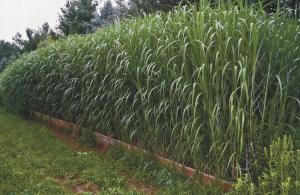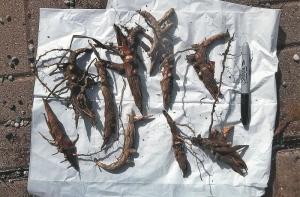2014 - Volume #38, Issue #2, Page #31
[ Sample Stories From This Issue | List of All Stories In This Issue | Print this story
| Read this issue]
Giant Grass Has Many Uses
 |
 |
Best of all, it’s easy to grow, says Kathy Carrigan, who along with her husband, Tom, grows and sells the giant grass through their business, Lacy Creek Growers.
The Vermontville, Mich., couple stumbled onto Miscanthus a few years ago when they were buying plants to grow at their rural nursery. They purchased one pot and were surprised at the interest it attracted when they posted it on their website. They found a couple of growers to meet the demand and started propagating the giant grass on their property.
“Our business has changed to the point where this is now our main product, along with other unusual landscape plants,” says Carrigan.
Grown in Europe for 30 years as a biofuel crop, Miscanthus planted at 4,200 rhizomes/acre produces as much as 17 tons/acre and three times as much energy as corn – with little to no inputs. Plus, it’s a perennial that can produce for a couple of decades.
The Carrigans’ nursery isn’t large enough for the agriculture market, but homeowners and deer hunters throughout Zones 4-9 keep them busy filling orders.
“An average sale is 100 divisions for deer hunters or 30 divisions for a hedge,” Carrigan says.
While other companies sell individual rhizomes, the Carrigans sell larger bare root divisions as big as a hand that are much easier to start, grow up to 6 ft. tall, and triple or quadruple in rhizome mass in the first year. Individual divisions start at $2.89/each with discounts for larger orders ($2.59/each for 100 to 499 plants, for example). Miscanthus needs to be watered to get started, but once established does well in poor soils and drought.
The grass is a sterile cross between two Asian grasses so it doesn’t produce seeds. Legal in all states, it’s considered non-invasive because it can be easily controlled with herbicides around the perimeter. The rhizomes multiply similar to irises and can be dug up and divided every few years. Or they can be left alone to become dense foliage.
“At first we sold to homeowners who grow it for privacy screening. Then deer hunters found out about us,” Carrigan says. “They use it around blinds and for screening off property so people aren’t shining deer. Deer won’t cross it, and wildlife likes it for cover and bedding.”
Because it doesn’t deteriorate as fast as straw, some growers harvest it for bedding. In areas with a long enough season, Miscanthus grows a silvery plume in the fall. The grass can be cut back anytime after it has gone dormant or left alone to add landscape interest in the winter.
The Carrigans started shipping to Florida in January, but most orders go out starting in mid-March.
Contact: FARM SHOW Followup, Tom and Kathy Carrigan, Lacy Creek Growers, 7338 Kinsel Hwy., Vermontville, Mich. 49096 (ph 517 726-0026; www.lacycreekgrowers.com).

Click here to download page story appeared in.

Click here to read entire issue
To read the rest of this story, download this issue below or click here to register with your account number.




